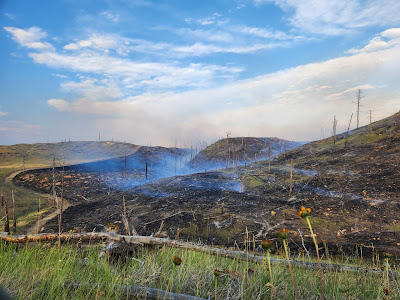“May we never stop
learning.”
Every year from June 30 through July 6 the National Wildfire
Coordinating Group’s 6 Minutes for Safety team takes the time to honor the act
of learning by going through thoughtful review and recognition of events from
the past in wildland fire, during the Week of Remembrance. This year’s theme is “Learning from the Mendocino
Complex.” Each day will focus on a topical area or event from the Mendocino
Complex that “has massive relevance on all incidents past, present, and
future.”
The hope is to encourage the fire community to be reflective
of our own thinking, emotions, communication style, and the limitations of
perspective on and off the fire ground.
“How can we study our
own thinking in order to be safer fire practitioners? Where do we start?
Within the somber context of tragedy, we are reminded that our
predecessors faced these same challenges. By renewing our commitment to refine
and evolve our craft, and to engage with events of the past as serious
students, we honor the fallen in the most meaningful way.
There is no doubt that, for many, this will be a
difficult week. Even many years removed, the trauma of those who share a
connection to an incident may become fresh and painful. We at 6 Minutes for
Safety will continue to educate and draw attention to the importance of
providing support for firefighter mental health. We ask our fellow and parent
committees to join us in this effort.”
“As Week of Remembrance 2024 embarks to honor the
events of the 2018 Mendocino Complex, our thoughts are also and always with the
Granite 19, who perished together on June 30, 2013. You are never forgotten.”
For Day One (which was Sunday June 30), we discuss the Incident Overview of the
Mendocino Complex. NWCG has the best overview so, we will pull directly from
their page:
Incident Background: The Mendocino Complex started on July 27, 2018, and
eventually became the largest wildfire at the time in California history,
burning 459,123 acres. When the complex’s Ranch and River Fires started, the
Northern California Geographic Area was at Preparedness Level (PL) 3. One other
large fire was burning in the region – the 28,000 acre Carr Fire, which went on
to burn 229,000 acres in the neighboring county. The day the Mendocino Complex
started, three other geographic areas and the nation were at PL 4, drawing
significant resource demand. The next day that increased to National PL 5.
Fire behavior was consistently extreme and large
fire growth was observed daily. On August 3rd a Fuels and Fire Behavior
Advisory was issued for the fire area citing a fine fuel crop at 180% of
normal, 1000-hr fuel moistures at record lows, and Energy Release Component
values at record highs. On August 4th, the Ranch and River Fires ran 50,000
acres.
Ultimately, several thousand firefighters from 34
different agencies would support suppression efforts, including the US National
Guard, US Army, Australia, and New Zealand Fire. Two Type 1 Incident Management
Teams (IMTs) were assigned to the complex due to its enormous size. However,
instead of assigning each IMT to half of the fire with geographically
determined boundaries, the teams operated out of the same Incident Command Post
in Ukiah, CA and essentially merged into one IMT, duplicating IMT positions and
areas of responsibility. This unusual organizational structure presented unique
operational challenges for management of an already complex, evolving
incident.
It cannot be overemphasized how coinciding events in
the regional fire environment contributed to a sense of tension and urgency
during the Mendocino Complex. 2018 was recorded as California’s deadliest and
most destructive wildfire season on record. Within days of the complex
igniting, two firefighters were killed on the Ferguson Fire in Yosemite
National Park. National political leaders visited fire camps throughout the
state. The growing Carr Fire competed for suppression resources and in November
the deadly Woolsey and Camp Fires ravaged communities preparing for the
holidays.
Bringing Forward
Lessons Learned: Although the chaotic backdrop leading up
to these events may sound extraordinary, incident response in the modern
wildfire environment is recreating similar situations with increasing frequency
each year. In this broader context, the fire response produced two significant
unintended outcomes: multiple firefighter injuries and a firefighter fatality
on August 13th, and an entrapment with multiple injuries on August 19th. For
the firefighters, dispatchers, pilots, and support personnel who were present,
these events and what led up to them will remain unforgettable. Week of
Remembrance 2024 aims to tell this story with integrity and respect, so that
the Mendocino Complex’s lessons learned may be of value for the broader fire
community to learn from.
Feel free to use the comments section below, or to
take these to your unit and have a discussion:
· Where were you in late July of 2018 when the
Mendocino Complex started?
· As you remember it, what contributed to the
atmosphere of this historic fire year?
Click here
to access further resources from the overview.





























.jpg)











